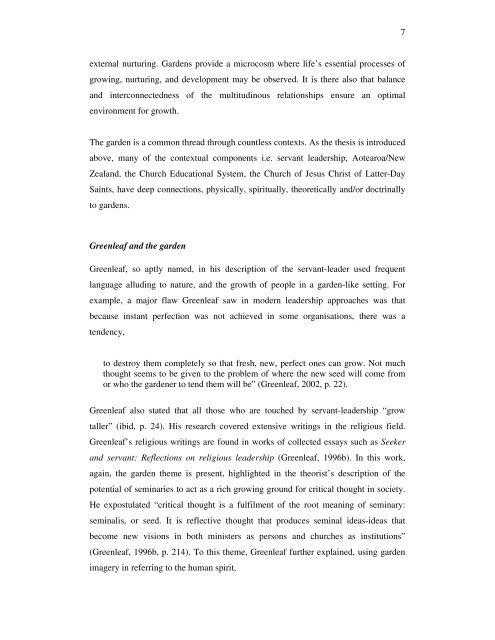nurturing servant leaders in religious education - Scholarly ...
nurturing servant leaders in religious education - Scholarly ...
nurturing servant leaders in religious education - Scholarly ...
You also want an ePaper? Increase the reach of your titles
YUMPU automatically turns print PDFs into web optimized ePapers that Google loves.
external <strong>nurtur<strong>in</strong>g</strong>. Gardens provide a microcosm where life’s essential processes of<br />
grow<strong>in</strong>g, <strong>nurtur<strong>in</strong>g</strong>, and development may be observed. It is there also that balance<br />
and <strong>in</strong>terconnectedness of the multitud<strong>in</strong>ous relationships ensure an optimal<br />
environment for growth.<br />
The garden is a common thread through countless contexts. As the thesis is <strong>in</strong>troduced<br />
above, many of the contextual components i.e. <strong>servant</strong> <strong>leaders</strong>hip, Aotearoa/New<br />
Zealand, the Church Educational System, the Church of Jesus Christ of Latter-Day<br />
Sa<strong>in</strong>ts, have deep connections, physically, spiritually, theoretically and/or doctr<strong>in</strong>ally<br />
to gardens.<br />
Greenleaf and the garden<br />
Greenleaf, so aptly named, <strong>in</strong> his description of the <strong>servant</strong>-leader used frequent<br />
language allud<strong>in</strong>g to nature, and the growth of people <strong>in</strong> a garden-like sett<strong>in</strong>g. For<br />
example, a major flaw Greenleaf saw <strong>in</strong> modern <strong>leaders</strong>hip approaches was that<br />
because <strong>in</strong>stant perfection was not achieved <strong>in</strong> some organisations, there was a<br />
tendency,<br />
to destroy them completely so that fresh, new, perfect ones can grow. Not much<br />
thought seems to be given to the problem of where the new seed will come from<br />
or who the gardener to tend them will be” (Greenleaf, 2002, p. 22).<br />
Greenleaf also stated that all those who are touched by <strong>servant</strong>-<strong>leaders</strong>hip “grow<br />
taller” (ibid, p. 24). His research covered extensive writ<strong>in</strong>gs <strong>in</strong> the <strong>religious</strong> field.<br />
Greenleaf’s <strong>religious</strong> writ<strong>in</strong>gs are found <strong>in</strong> works of collected essays such as Seeker<br />
and <strong>servant</strong>: Reflections on <strong>religious</strong> <strong>leaders</strong>hip (Greenleaf, 1996b). In this work,<br />
aga<strong>in</strong>, the garden theme is present, highlighted <strong>in</strong> the theorist’s description of the<br />
potential of sem<strong>in</strong>aries to act as a rich grow<strong>in</strong>g ground for critical thought <strong>in</strong> society.<br />
He expostulated “critical thought is a fulfilment of the root mean<strong>in</strong>g of sem<strong>in</strong>ary:<br />
sem<strong>in</strong>alis, or seed. It is reflective thought that produces sem<strong>in</strong>al ideas-ideas that<br />
become new visions <strong>in</strong> both m<strong>in</strong>isters as persons and churches as <strong>in</strong>stitutions”<br />
(Greenleaf, 1996b, p. 214). To this theme, Greenleaf further expla<strong>in</strong>ed, us<strong>in</strong>g garden<br />
imagery <strong>in</strong> referr<strong>in</strong>g to the human spirit,<br />
7

















